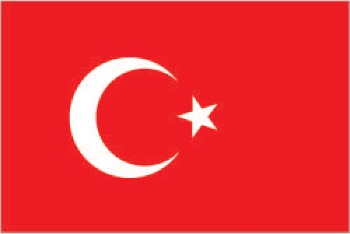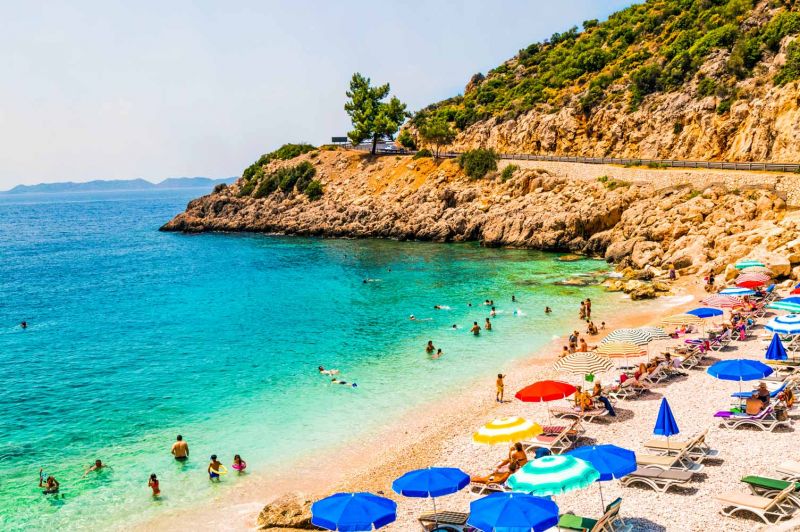Turkey, the official name of the Republic of Turkey, is a transcontinental country . This is because it is located on two continents : most in Asia, and the smallest in Europe.
It is the third most populous country in Europe, behind Russia and Germany.
Location
The country is bathed by the following seas: Black Sea, Mediterranean Sea, Aegean Sea and Marmara Sea. It borders eight countries: Armenia, Azerbaijan, Bulgaria, Georgia, Greece, Iran, Iraq and Syria.

Capital: Ankara or Istanbul?
Ankara is the capital of Turkey.

Many people think that Istanbul is the capital of Turkey. This is because Istanbul was once the capital of the Eastern Roman Empire and the Ottoman Empire .

But since 1923, after the fall of the Ottoman Empire, Turkey’s capital is Ankara.
Istanbul is the country’s main city and the only bi-continental city in the world. Part of it is in Asia and the other part is in Europe. It is a megacity, considering that it houses more than 10 million inhabitants.
Flag

The flag of Turkey is red. In addition to red, the color white is present in the symbols that compose it: the crescent moon with the star, the main symbol of Islam.
Its true origin is unknown. Possibly, it arose in the period of the Ottoman Empire, given the similarity between the flags.
Economy
The GDP per capita of 10,299 US $. The main sectors of the Turkish economy are agriculture, industry and tourism. Turkey produces a lot of nuts and grains, with greater evidence in the cultivation of wheat.
In the industry, the automobile sector stands out, since the country is one of the largest automobile producers in the world. The textile industry is also quite strong.
About 39 million tourists visit the country annually.
Culture
Turks have a habit of drinking tea. On average, they drink about ten cups daily. Another custom is to leave your shoes at the entrance to the houses. When visiting someone, the hosts provide slippers at the entrance.
Superstitious, it is common to use the Turkish eye, an amulet. This object can be hung in homes or placed on babies’ clothes.
In Turkey, kissing between men is a common greeting. Likewise, it is normal to see friends walking hand in hand.
Ninety-nine percent of Turks follow Islam . This religion, however, is not the country’s official religion, because Turkey follows the principle of Secularism.
In Secularism, there is religious freedom and the political system is not influenced by religion.
For religious reasons, women’s garments cover their entire bodies. The clothes are dark. Religious men, in turn, wear a turban.
For wedding ceremonies, the bride and groom dress just like in the West: the bride in a white dress, the groom in a suit.
The big difference is the gifts that are offered. In Turkey, the bride and groom earn jewelry and money. The jewels are placed on the bride, who stays with them during the party.
Relief
The Asian part of Turkey consists of a large plateau located in the center and around it what predominates are young mountains that have undergone few erosion processes.
To the north there is the Pontic Mountains and to the south, the Taurus Mountain Range, in addition to a plain cut by several interior basins, on the eastern side it presents the Armenian massif where high reliefs occur with volcanic formation where the highest point of Turkey is found, with 5,137 meters of altitude.
Climate
In Turkey there are four climatic characteristics, on the south and west coast the Mediterranean climate occurs, in July the average temperature is 29ºC. In the north, summers are pleasant and cold winters with a high incidence of rain. In the center of the country, it develops a dry climate with a wide temperature difference between the summer and winter seasons
Hydrography
As for the hydrographic basins, it occurs mostly within the territory where Lake Van is located, located at an altitude of 1,720 meters. To the north the main rivers are Sakarya, Kizil Irmak and Yesil that flow into the Black Sea. In addition to the Simav river that flows into the Marmara Sea, Gediz and Buyukmenderes in the Aegean Sea and the Seyhan and Orontes rivers in the Mediterranean Sea.
In the east of the territory, important rivers are born, such as the Tigris and the Euphrates, which flow into the Persian Gulf.
Vegetation
As for vegetation cover, what predominates are coniferous forests in the northern mountains and also in the plains. The Mediterranean vegetation with shrub characteristic develops in coastal areas of the Aegean and Mediterranean Sea.
Another vegetative characteristic that is present in Turkish territory is the steppe, common in areas with limited incidence of rainfall in a semi-desert climate. The best known trees typical of the region are oak, pine, cedar, palm and fir.

Regarding fauna, the typical wild animals of the region are wolves, foxes, wild boars, mountain cats, beavers, minks, jackals, hyenas, deer and mountain goats, in addition to domestic animals such as buffalo, angora goat and camel.
Language
The official language is Turkish, but there is a part of the population that speaks Kurdish and a minority speaks Arabic. The second language is English, being more present in the tourist and tourism professionals.
Gastronomy
Turkish cuisine is exceptionally incredible and very rich. There are thousands of dishes, but we have chosen some highlights that you need to try when in Turkey: peynir (cured sheep cheese), dolman, zaytinyagli, kebab, Turkish coffee, Turkish tea, simit, pide, pita bread, köfte, dondurma (ice cream ), lokum (Turkish delight) and baklava.

